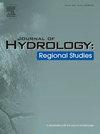Risk spatial distribution and economic loss assessment for parallel reservoir group dam-break floods: A case study of southwest river basin in China
IF 4.7
2区 地球科学
Q1 WATER RESOURCES
引用次数: 0
Abstract
Study region
Zhaotong City, located in the Jinsha River Watershed in southwest China, features a developed river network, mountainous terrain, and significant elevation changes. The region experiences a low-latitude plateau monsoon climate, with rainfall concentrated in the wet season.
Study focus
This study uses a 2D hydrodynamic model and a dam-break flood model to assess flood risks of parallel reservoirs and quantify direct economic losses under different scenarios. It also explores the causes of risk and loss variations across scenarios.
New hydrological insights for the region
Differences in dam site locations and downstream topography result in significant variations in inundation areas, with extreme cases differing by nearly twofold. Dam-break flood losses depend on inundation extent, water depth, and land value. Variations in high-value land inundation, such as residential, commercial, and industrial areas, are the main reason for differences in direct economic losses. The fatality area of a dam-break flood from parallel reservoirs is smaller than the sum of individual reservoirs due to river confluence effects, delaying the flood's arrival at the city center. Overall, parallel reservoir dam-break risks are influenced by multiple factors, requiring case-specific analysis rather than simple risk summation.
求助全文
约1分钟内获得全文
求助全文
来源期刊

Journal of Hydrology-Regional Studies
Earth and Planetary Sciences-Earth and Planetary Sciences (miscellaneous)
CiteScore
6.70
自引率
8.50%
发文量
284
审稿时长
60 days
期刊介绍:
Journal of Hydrology: Regional Studies publishes original research papers enhancing the science of hydrology and aiming at region-specific problems, past and future conditions, analysis, review and solutions. The journal particularly welcomes research papers that deliver new insights into region-specific hydrological processes and responses to changing conditions, as well as contributions that incorporate interdisciplinarity and translational science.
 求助内容:
求助内容: 应助结果提醒方式:
应助结果提醒方式:


